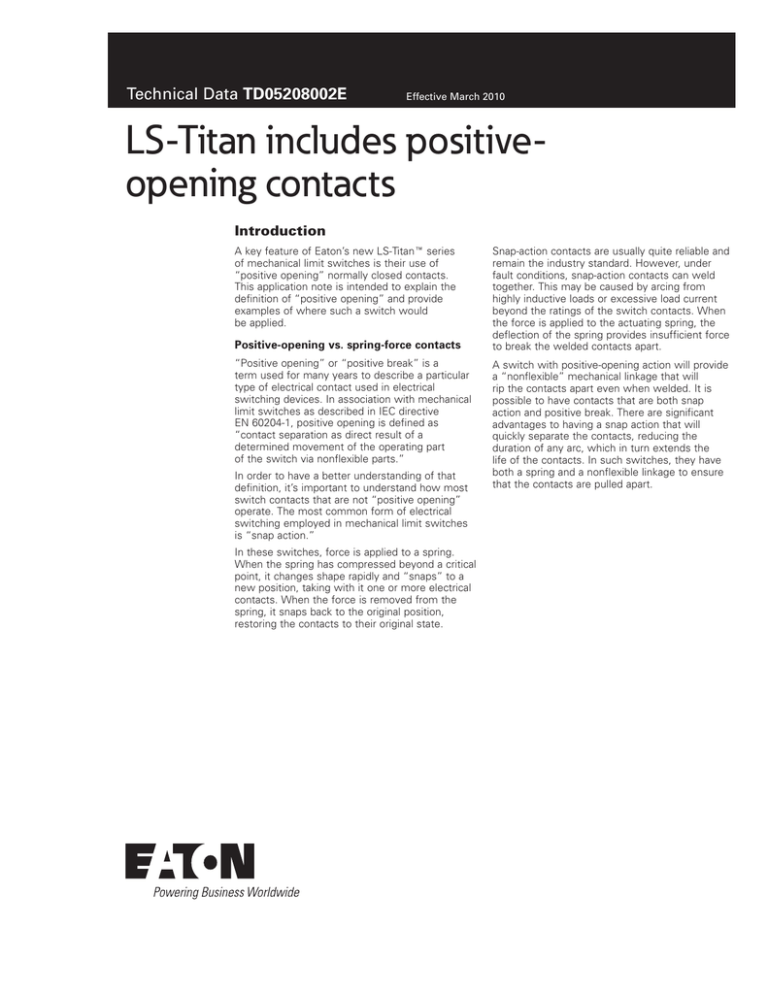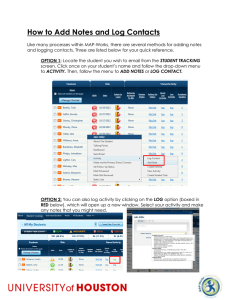
Technical Data TD05208002E
Effective March 2010
LS-Titan includes positiveopening contacts
Introduction
A key feature of Eaton’s new LS-TitanE series
of mechanical limit switches is their use of
“positive opening” normally closed contacts.
This application note is intended to explain the
definition of “positive opening” and provide
examples of where such a switch would
be applied.
Positive-opening vs. spring-force contacts
“Positive opening” or “positive break” is a
term used for many years to describe a particular
type of electrical contact used in electrical
switching devices. In association with mechanical
limit switches as described in IEC directive
EN 60204-1, positive opening is defined as
“contact separation as direct result of a
determined movement of the operating part
of the switch via nonflexible parts.”
In order to have a better understanding of that
definition, it’s important to understand how most
switch contacts that are not “positive opening”
operate. The most common form of electrical
switching employed in mechanical limit switches
is “snap action.”
In these switches, force is applied to a spring.
When the spring has compressed beyond a critical
point, it changes shape rapidly and “snaps” to a
new position, taking with it one or more electrical
contacts. When the force is removed from the
spring, it snaps back to the original position,
restoring the contacts to their original state.
Snap-action contacts are usually quite reliable and
remain the industry standard. However, under
fault conditions, snap-action contacts can weld
together. This may be caused by arcing from
highly inductive loads or excessive load current
beyond the ratings of the switch contacts. When
the force is applied to the actuating spring, the
deflection of the spring provides insufficient force
to break the welded contacts apart.
A switch with positive-opening action will provide
a “nonflexible” mechanical linkage that will
rip the contacts apart even when welded. It is
possible to have contacts that are both snap
action and positive break. There are significant
advantages to having a snap action that will
quickly separate the contacts, reducing the
duration of any arc, which in turn extends the
life of the contacts. In such switches, they have
both a spring and a nonflexible linkage to ensure
that the contacts are pulled apart.
LS-Titan includes positive-
opening contacts
Technical Data TD05208002E
Effective March 2010
Application
Traditional SpringDriven Contacts (NC)
When are positive-opening contacts required? The choice of
positive-opening contacts is determined by the machine designer.
There are a number of domestic and international standards that
specify the use of positive-opening contacts in machine design.
If designing a machine for export to any of the European Union
(EU) member countries, the machine builder must ensure that the
machine conforms to all applicable EU directives. Even if positiveopening contacts are not specifically required, using a limit switch
with such contacts positions the design so that conformance will
be made easier if it ever becomes a future requirement.
What kind of application would use a limit switch with positiveopening contacts? The possibilities are many. In general, a typical
application could be where a switch is providing feedback about
the status of a machine part. Is the door closed? Is the vent open?
Has the target reached the top limit of travel? Is the tank cover in
place? All of these applications could be accomplished with limit
switches that do not have positive-opening contacts. The key
difference will be the safety requirements of the machine design.
To know for sure, one begins with the safety standards and works
from there. When in doubt, err on the side of caution and specify
positive-opening contacts.
Positive-Opening
Contacts (NC)
Figure 1. Conventional vs. Positive-Opening Contacts
Eaton Corporation
Electrical Sector
1111 Superior Ave.
Cleveland, OH 44114
United States
877-ETN-CARE (877-386-2273)
Eaton.com
© 2010 Eaton Corporation
All Rights Reserved
Printed in USA
Publication No. TD05208002E / Z9643
March 2010
PowerChain Management is a registered
trademark of Eaton Corporation.
All other trademarks are property of their
respective owners.


